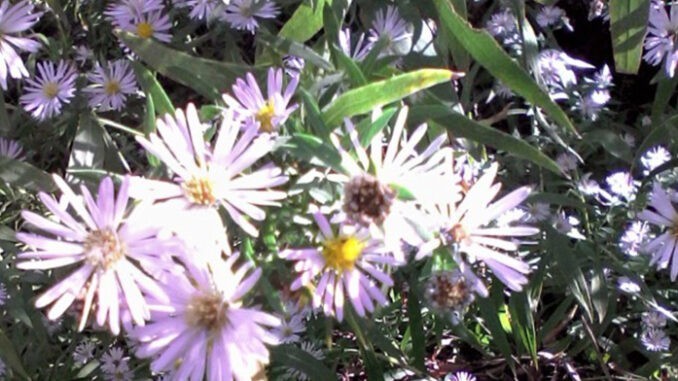
The Panicled Aster (Symphyotrichum lanceolatum) is called the “Day of the Dead Flower” because of its use to decorate graves in an early November Mexican ceremony (Dia De Los Muertos) which honors those who have passed. This aster is one of several flowers used in these ceremonies. Other names include: panicle aster, tall white aster, eastern line aster, lance-leaf aster, narrow-leaf Michaelmas daisy, and white-panicle aster.
The flowers with white petals and a yellow center occur from Canada, throughout the U.S. and into Mexico. October is their peak season for blooming. (See more images here.)
The perennial flowers grow in clumps up to five feet tall and wide (sometimes larger). The petals turn more lavender-colored as the season progresses. The green leaves are up to six inches long. The green stems, which turn brown with age, are often grooved and have lines of hairs.
The nectar and pollen attract many kinds of bees, wasps, and butterflies as well as many other insects. Birds and mice feed on the seeds. Herbivores, including deer, rabbits, groundhogs, horses, cattle, and sheep, browse on the foliage.
The Zuni people used this plant for wounds and nosebleed. A salve of the dried plant was applied to skin abrasions. The smoke from burning dried flowers treated nosebleed. Tea made from the blossoms produces a calming effect much like chamomile. The Iroquois used it to treat fever.

I took the photo at the Arizona-Sonora Desert Museum where the flowers are growing between the butterfly garden and the hummingbird aviary. ASDM says these flowers do well in a watered garden, part shade or full sun, or in a large patio container. They are frost tolerant and can be pruned in the spring.
Note to readers:
Visit my blog at: https://wryheat.wordpress.com/
Index with links to all my ADI articles: http://wp.me/P3SUNp-1pi
My comprehensive 30-page essay on climate change: http://wp.me/P3SUNp-1bq
A shorter ADI version is at https://arizonadailyindependent.com/2013/08/01/climate-change-in-perspective/
[metaslider id=178468]
